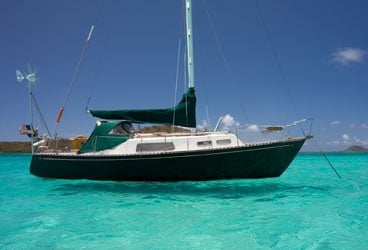
Grampian 30 368
Jim Bisiker founded Grampian Marine Ltd. in the early 1960s in Ontario, Canada. At one point, the company operated a second plant in North Carolina. After building boats to the plans of several designers, Grampian took on Alex McGruer to design the Grampian line in-house. Before closing in the late 1970s, it built about 400 Grampian 30s, 50 of them cutters.
From its reverse stern to its spoon bow, the Grampian 30 has a springy sheer and sweet lines. The cabin trunk is clearly of 1970s vintage, but considering that the boat is a shade under 30 feet and has 6 feet 4 inches of headroom, McGruer did well to keep it from looking overly chunky.
For a boat its size, the Grampian 30 has ample accommodations. Its conventional layout contains a large, long quarter berth to port, which is a great sea berth. To starboard is an L-shaped galley. Some owners have upgraded from the two-burner alcohol stove to one with a full oven. Others have added refrigeration to the icebox, which is accessible from both the galley and the cockpit.
On the port side of the saloon, the dining table drops down to convert the U-shaped settee into a double berth. The table contains stowage for charts and doubles as the chart table. The settee to starboard is the only berth with which someone taller than 6 feet might struggle. Large portlights keep the area light and airy.
Forward of the saloon, a small head is on the port side; opposite it, there’s a hanging locker with a shelf above. The forward cabin has a V-berth that’s long and wide; bins, drawers, and shelves are available for stowage.
The cockpit is large enough for a tall person to stretch out easily and, with the tiller hinged up out of the way, will seat several people comfortably. (A few boats have been converted to wheel steering.) The two 1-inch-diameter cockpit drains are adequate for rain but a little slow for a boarding wave. Some owners have enlarged them or added new ones.
Overall, owners seem pleased with the sailing performance of the Grampian 30. It’s stiff and dry, even the centerboard version, but given its high ballast ratio (.45), it’s not hard to see why. It won’t outpace or outpoint more modern designs, but it balances well and, on a close reach in moderate conditions, will track for hours with no one at the helm.
A few items on the G30s might require some attention. The original aluminum stemhead fitting should be replaced with stainless steel. The bedding around the portlights may need renewing. Water can leak around the chainplate from the port-side cap shroud and soften the main bulkhead to which it’s bolted. This area is hidden beneath the fiberglass tabbing between the bulkhead and the hull. All the other chainplates attach to built-up fiberglass tabs integral to the hull and are strong, though many owners have added backing plates.
Access to the forward half of the engine is good, but the transmission and the stuffing box are both difficult to reach, prompting some owners to cut a watertight hatch in the cockpit sole.
Despite the strong build of the Grampian 30-materials were inexpensive in the 1970s-it falls into the coastal-cruiser category. That said, several have made long bluewater passages.
Much of the Grampian 30’s original appeal was that it was a lot of boat for the money. At current prices of between $12,000 and $15,000 (with a few outstanding examples above $20,000), it still is, and many have been improved or repowered. Grampian owners support a very helpful website (www.grampianowners.com).
Bryan Allen is a photographer. When he’s home, he and his wife sail their Grampian 30, Avocet, along the South Shore of New York’s Long Island. \
Grampian 30
LOA 29′ 9″ (9.07 m.)
LWL 25′ 6″ (7.77 m.)
Beam 9′ 6″ (2.90 m.)
Draft 4′ 8″ (1.42 m.)
Sail Area (100%) 390 sq. ft. (36.2 sq. m.)
Ballast 3,870 lb. (1,755 kg.)
Displacement 8,600 lb. (3,900 kg.)
Ballast/D .45
D/L 232
SA/D 14.9
Water 20 gal. (75.7 l.)
Fuel 18 gal. (68.1 l.)
Engine Various
Designer Alex McGruer








